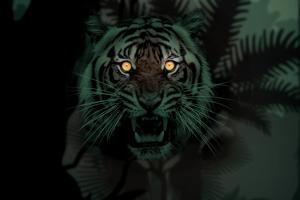As the hunt for the tigress T1, that is said to have killed 13 people in Pandharkawda, continues, here's how the human-wildlife conflict is tackled in the rest of India

Illustration/ Ravi Jadhav
What is human-wildlife conflict
The Worldwide Fund for Nature defines human-animal conflict as a fight over living space and food. As human populations grow and natural habitats shrink, people and animals are increasingly in conflict, with both losing their lives.
Dr Vinaya Jangale, Livestock Development Officer, Khed, recalled the case of a herd of elephants that had strayed into Sawantwadi. They were successfully herded back into Karnataka where they came from. Jangale said, "They would enter a farm every night and drink water from a tank. They did not damage property or crops, but the farmer put a live wire around the tank to stop them. The intelligent and vindictive animals then kept going to the farmer's house at night to try and break it."
ADVERTISEMENT
Anish Andheria, president, Wildlife Conservation Trust, says human-wildlife conflicts occur because of fragmentation of forests, illegal grazing, forest fires lit on purpose and when people go into protected areas to collect wood.
How a rogue big cat is captured
1 Camera traps are set up near the kill site to confirm the ID of the animal. Until the animal is identified from pictures, it is not advisable to tranquilise it
2 Sometimes fresh bait is put up in an adjacent cage
3 If trapping fails, chemical immobilisation (tranquilising) is done
4 If the captured big cat is healthy, it is released after it is microchipped, away from human settlements.
Ustad behind bars
Kedar Gore, director, Corbett Foundation, narrates the case of Ustad, a beautiful tiger in Ranthambore National Park, to illustrate what happens to animals captured in human-wildlife conflicts. Tagged man-eater, he was relocated, then kept in captivity. There still are fights over translocating him.
While Ustad continues to be alive in captivity, a leopard, Gore says, was not so 'lucky'. It was captured and caged, to be taken away from the area where it was said to have killed humans. Gore says, furious with the FD's delay in capturing the animal, locals set the cage afire, killing it, and even threatened rangers with the same.
How the issue is tackled abroad
Botswana
The preventive strategies in 2016 included the use of chilli pepper to deter elephants, the use of herding dogs to guard against predators, construction of kraals and ploughing early maturing seeds and bee keeping. Dogs had also been provided to deter wild animals. The dogs were provided food by authorities. The Botswana Predator Conservation Trust even helped some farmers to paint eyes on their cattle, to deter lions.
Namibia
The Desert Lions Human Relations Aid (DeLHRA), reports The Guardian, has suggested that people cover kraals where they keep their livestock, with cloth. Lions then view it as solid. They also gave farmers solar-powered lights, sirens, air horns and other measures to ward off lions
Tanzania
The Ruaha Carnivore Project began predator-proofing livestock enclosures in 2012. Fortifying these enclosures with chain-link fencing has proven effective in protecting livestock
How a rogue elephant is captured
A rogue elephant is tranquilised before capture
1 Rogue elephants are captured with the help of kumkis or trained elephants
2 After trapping it, it is tied with ropes and a kraal -- wooden cage -- is built around it
3 After it is kept there for a while, it is released into denser forests or sent to a zoo or trained for work
'Forest department staff are trained and have good equipment. So the contrary allegations by the Nawab are false. But we need a task force for such situations. We also need a vet at district level, to help with wild animals'
Dr Vinaya Jangale
Livestock Development Officer, Khed
T1's tale
The tigress is said to have killed 13 people since 2016. She moved to Pandharkawda from the nearby Tipeshwar Wildlife sanctuary, around 70 km from the conflict zone. It is speculated that her mother pushed her out and, in search of her own territory, she moved to Pandharkawada where she now roams with two 10-month-old cubs. Officials feel she might be teaching the cubs to hunt and might make them too fear humans less
'Locals are being educated on how to co-exist with wildlife, but the conflicts will not stop until their dependence on forests goes down'
Anish Andheria, President, Wildlife Conservation Trust
'Many human-wildlife conflict incidents are localised. Every taluka has animal husbandry veterinarians. They should be trained to deal with wildlife. There is also the need for a rapid action team to help with such situations'
Vidya Athreya, Centre for Wildlife Studies
'Our forest departments (FD) have enough manpower and are capable. We also have scientific know-how. Only, they should react faster. But, there is a need for a special task force to deal with human-wildlife conflict. A hunter like Nawab Shafat Ali Khan should not be called again'
Kedar Gore,Director,
Corbett Foundation
Catch up on all the latest Mumbai news, crime news, current affairs, and also a complete guide on Mumbai from food to things to do and events across the city here. Also download the new mid-day Android and iOS apps to get latest updates
 Subscribe today by clicking the link and stay updated with the latest news!" Click here!
Subscribe today by clicking the link and stay updated with the latest news!" Click here!







